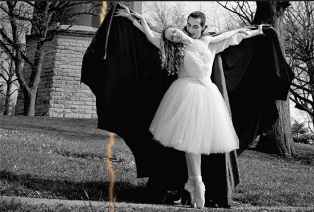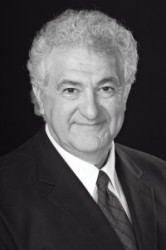
More Frightening Than Dracula
I saw Cincinnati Ballet’s “Dracula” on Halloween night at
the Aronoff Center and I am still scared to death.

Not by Anthony Krutzkamp’s drop dead Dracula and his predatory wives, the creepy fog or Krutzkamp’s even creepier crawl down the wall of Dracula’s castle. It wasn’t the holiday crowd either, though there were spooks galore with scary makeup, fake blood and horns.
What really scared me – and continues to scare me – was the thought of ballet without music. Without live music, that is. This “Dracula,” a world premiere choreographed by Ballet associate artistic director Devon Carney, was a case in point. What creaked through the sound system in Procter and Gamble Theater was harsh and ugly – undead, perhaps – certainly no substitute for the full-bodied, rounded sound of a living, breathing orchestra in the pit.
Oh yes, the villain is money, and Cincinnati Ballet is trying to raise an endowment to insure the continuation of live music for its performances. So far, only music director Carmon DeLeone’s “Peter Pan” (February 11-15) will enjoy that “luxury” this season.
Many people at
“Dracula” lamented the quality of the music they heard. This is not to detract from Carney’s outstanding
achievement in assembling a score in a remarkably short 5 ½ months -- in addition
to crafting the story and doing the choreography. Carney’s sources were all 20th-century music: Philip Glass’ 1999 re-scoring of the 1931 Bela Lugosi “Dracula” (Kronos Quartet), Wojciech Kilar’s score for Francis
Ford Coppola’s 1994 “Bram Stoker’s Dracula,” plus music by Francis Poulenc (“L’Invitation au chateau”) and various
pieces by Henryk Gorecki.

Loosely based on Stoker’s 1897 novel, the story was told in fast-moving, cross-cut scenes, giving it a “crossover” aspect fully in tune with the overall trend in the arts today. Carney’s choreography partook as much of stage drama as ballet, though to this admitted non-expert, it was fully satisfying as dance. Especially beautiful was the pas de deux by Sarah Hairston and Zack Grubbs as Mina Murray and her fiancé Jonathan Harker as Mina dreams of Jonathan in her room (to “Love Remembered” from Kilar’s “Dracula” score). It was fun to see the spellbound Lucy Westenra (Janessa Touchet) drawn helplessly en pointe to the cemetery by Dracula, and Selahattin Erkan as a mustachioed Prof. van Helsing leap vigorously across the stage.
Cervilio Amador’s epileptic contortions as the insect-eating, asylum inmate Renfield may not have been the stuff of conventional choreography, but they were quite effective in telling the story. Similarly, dancers usually don’t decapitate their colleagues onstage, though it fit very well here when Jonnathan Ramirez as Arthur Holmwood discovered his fiancee Lucy as a newly minted vampire in her coffin and lopped off her head with a shovel. Most likely the show will become a popular seasonal event, as Dracula ballets across the country have apparently become (including David Nixon’s “Dracula” for BalletMet Columbus, performed in Cincinnati in 2001).
Still, it would be far
more satisfying and complete with live music.
Cincinnati Ballet is one of only a handful of U.S. ballet companies that
continue to utilize an in-house orchestra.
Created by DeLeone from area professionals in 1968, the Cincinnati
Ballet Orchestra is a vital asset if the company is to retain its position among
the nation’s best. DeLeone, who is celebrating his 40th
anniversary this year as CB music
director, has kept the standard of performance high by working closely with both
the dancers and the musicians, to say nothing of composing original scores for the ballet. Nothing can afford dancers the freedom and
flexibility of live music and a real conductor in the pit.

The annual cost for live music for Cincinnati Ballet performances is approximately $300,000, depending on repertoire and scheduling. Members of the community are urged to help the company keep its edge by donating to Cincinnati Ballet’s Live Music Task Force. For information, call (513) 621-5219.